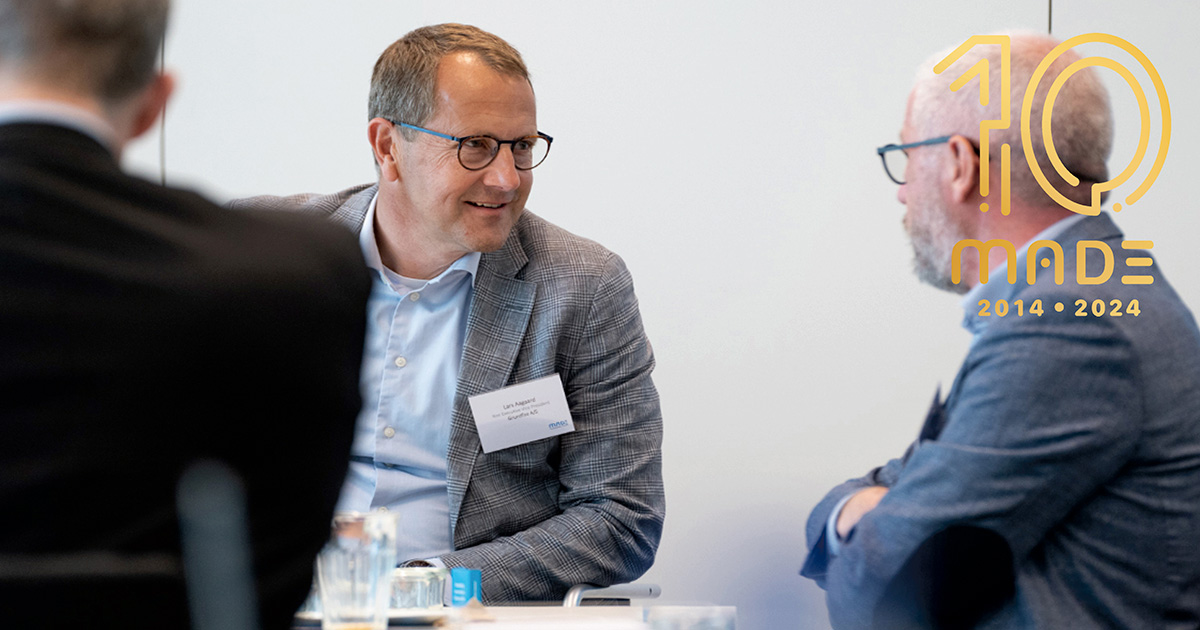MADE’s 10th anniversary: Lars Aagaard, who has been part of the top management at Grundfos since 2003, chronicles how the biggest players in Danish manufacturing joined forces to save manufacturing in Denmark when the ecosystem was heading towards a collapse.

MADE celebrates its 10th anniversary by publishing a series of articles about recent manufacturing history – and MADE’s part in it. The articles evolves around the development from decline and outsourcing to high-tech and growth. Join us on this journey!
“There was a widespread belief that manufacturing simply wasn’t important for Denmark’s future,” says Lars Aagaard, who has been a member of the senior management of global water solutions giant Grundfos since 2003 – initially as Group Executive Vice President and now as Non-Executive Vice President.
“This was difficult for some of us industrial companies to comprehend,” he continues.
Throughout the 00s, more and more manufacturing companies were relocating their production beyond Denmark’s borders. From 2001 to 2006, nearly 4,000 industrial jobs at companies with more than 50 employees were offshored, according to one Statistics Denmark analysis (in Danish).
If the production moves an entire ecosystem disappears
You might be wondering about the effects of offshoring low-paying jobs and polluting manufacturing processes to other countries, especially given the political policy at the time, which was that Denmark should profit from knowledge rather than production, as declared by Prime Minister Anders Fogh Rasmussen in a speech to the Danish parliament, Folketinget, in 2005, in which he presented his coalition government’s goals for his term in office. But moving manufacturing to other countries would pull the rug out from under an entire ecosystem, explains Aagaard.
“If we didn’t do something, there would no longer be any manufacturing in Denmark. An entire ecosystem of designers, engineers, academics and manufacturers would disappear. But there is also an interaction between manufacturing and product development, which requires knowledge-sharing,” he elaborates.
According to Aagaard, there were “far too few engineers and PhDs specialising in manufacturing. As a result, in the late 00s and early 10s, Grundfos and other companies began sourcing R&D from beyond Denmark’s borders:
“The ecosystem couldn’t just be built up again. I remember it as a matter of do something now, or never.”
A turning point
After several attempts to make their voices heard by policy-makers in collaboration with the Confederation of Danish Industry, Denmark’s manufacturing giants decided to take things into their own hands in 2013. Danfoss, Grundfos, Siemens, Terma, The LEGO Group, Danish Crown and NKT Photonics joined forces with knowledge institutions and universities as well as the Danish Industry Foundation and the Confederation of Danish Industry to establish MADE and the SPIR project, which comprised a series of research projects with the common goal of uniting and saving Danish manufacturing.
“MADE is proof that when companies work together and show a genuine willingness to throw time and money on the table, then it was actually possible to gain public backing. So we had the support of Danish society in general,” says Aagaard.
MADE is proof that when companies work together and show a genuine willingness to throw time and money on the table, then it was actually possible to gain public backing. So we had the support of Danish society in general
Lars Aagaard
The launch of MADE and MADE SPIR was financed by companies, Innovation Fund Denmark, the Danish Industry Foundation, universities and private funds and associations.
By that time, the political climate was changing. In a speech at a conference in 2013, Prime Minister Helle Thorning-Schmidt declared that “Denmark is a manufacturing nation. And Denmark should always be one”.
The original aim of MADE was to bring together Danish manufacturing know-how and to ensure that the needs of Danish companies set the course for research in the field.
Everybody could see and sense it
According to Aagaard, SPIR was “the breakthrough”:
“A joint vision evolved, and we all grew closer and gained a better understanding of each other’s strengths. Suddenly, there was a new dynamic and a fresh interest in the manufacturing sector”.
SPIR became the launching pad for MADE in 2014. Around 22 MADE PhDs were hired by manufacturing companies that year, and that figure grew to 48 as companies, universities and others funded additional researchers throughout SPIR’s lifetime – a doubling of past figures, according to Aagaard.
“There was a serious shift in gear and everyone could see and sense it. There was a tremendous energy in the network. All those PhD fellows were no longer working in isolation on their own projects, but interacting across sectors. MADE helped change the narrative about Danish manufacturing,” he says, adding:
“And it resonated – also beyond Denmark’s borders.”
Today, MADE has been designated the Danish Cluster for Advanced Manufacturing, thus making manufacturing one of 14 positions of strength spotlighted by the Danish government as action areas moving forward. SPIR was followed by the Digital and FAST projects, which brought significant financial gains to companies, as well as training a great many PhD and postdoctoral researchers. Moreover, in addition to advancing research, MADE has increased the number of annual events and projects on offer to strengthen all types of manufacturing companies and the entire manufacturing ecosystem.